Input interpretation

K_2CO_3 pearl ash + Ba(NO_3)_2 barium nitrate ⟶ KNO_3 potassium nitrate + BaCO_3 barium carbonate
Balanced equation
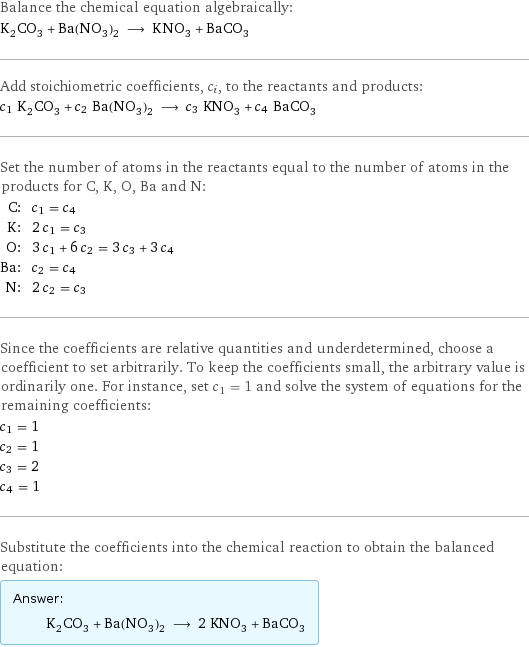
Balance the chemical equation algebraically: K_2CO_3 + Ba(NO_3)_2 ⟶ KNO_3 + BaCO_3 Add stoichiometric coefficients, c_i, to the reactants and products: c_1 K_2CO_3 + c_2 Ba(NO_3)_2 ⟶ c_3 KNO_3 + c_4 BaCO_3 Set the number of atoms in the reactants equal to the number of atoms in the products for C, K, O, Ba and N: C: | c_1 = c_4 K: | 2 c_1 = c_3 O: | 3 c_1 + 6 c_2 = 3 c_3 + 3 c_4 Ba: | c_2 = c_4 N: | 2 c_2 = c_3 Since the coefficients are relative quantities and underdetermined, choose a coefficient to set arbitrarily. To keep the coefficients small, the arbitrary value is ordinarily one. For instance, set c_1 = 1 and solve the system of equations for the remaining coefficients: c_1 = 1 c_2 = 1 c_3 = 2 c_4 = 1 Substitute the coefficients into the chemical reaction to obtain the balanced equation: Answer: | | K_2CO_3 + Ba(NO_3)_2 ⟶ 2 KNO_3 + BaCO_3
Structures

+ ⟶ +
Names

pearl ash + barium nitrate ⟶ potassium nitrate + barium carbonate
Reaction thermodynamics
Enthalpy
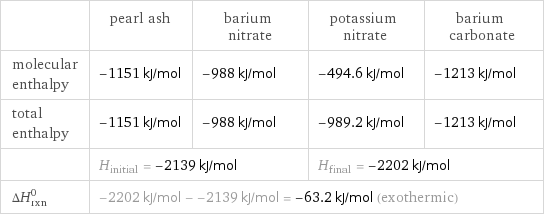
| pearl ash | barium nitrate | potassium nitrate | barium carbonate molecular enthalpy | -1151 kJ/mol | -988 kJ/mol | -494.6 kJ/mol | -1213 kJ/mol total enthalpy | -1151 kJ/mol | -988 kJ/mol | -989.2 kJ/mol | -1213 kJ/mol | H_initial = -2139 kJ/mol | | H_final = -2202 kJ/mol | ΔH_rxn^0 | -2202 kJ/mol - -2139 kJ/mol = -63.2 kJ/mol (exothermic) | | |
Gibbs free energy
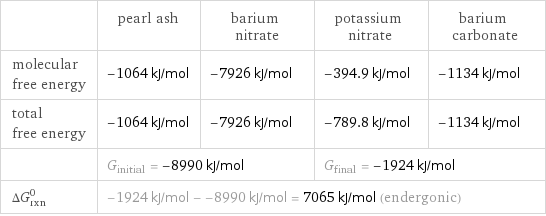
| pearl ash | barium nitrate | potassium nitrate | barium carbonate molecular free energy | -1064 kJ/mol | -7926 kJ/mol | -394.9 kJ/mol | -1134 kJ/mol total free energy | -1064 kJ/mol | -7926 kJ/mol | -789.8 kJ/mol | -1134 kJ/mol | G_initial = -8990 kJ/mol | | G_final = -1924 kJ/mol | ΔG_rxn^0 | -1924 kJ/mol - -8990 kJ/mol = 7065 kJ/mol (endergonic) | | |
Equilibrium constant
![Construct the equilibrium constant, K, expression for: K_2CO_3 + Ba(NO_3)_2 ⟶ KNO_3 + BaCO_3 Plan: • Balance the chemical equation. • Determine the stoichiometric numbers. • Assemble the activity expression for each chemical species. • Use the activity expressions to build the equilibrium constant expression. Write the balanced chemical equation: K_2CO_3 + Ba(NO_3)_2 ⟶ 2 KNO_3 + BaCO_3 Assign stoichiometric numbers, ν_i, using the stoichiometric coefficients, c_i, from the balanced chemical equation in the following manner: ν_i = -c_i for reactants and ν_i = c_i for products: chemical species | c_i | ν_i K_2CO_3 | 1 | -1 Ba(NO_3)_2 | 1 | -1 KNO_3 | 2 | 2 BaCO_3 | 1 | 1 Assemble the activity expressions accounting for the state of matter and ν_i: chemical species | c_i | ν_i | activity expression K_2CO_3 | 1 | -1 | ([K2CO3])^(-1) Ba(NO_3)_2 | 1 | -1 | ([Ba(NO3)2])^(-1) KNO_3 | 2 | 2 | ([KNO3])^2 BaCO_3 | 1 | 1 | [BaCO3] The equilibrium constant symbol in the concentration basis is: K_c Mulitply the activity expressions to arrive at the K_c expression: Answer: | | K_c = ([K2CO3])^(-1) ([Ba(NO3)2])^(-1) ([KNO3])^2 [BaCO3] = (([KNO3])^2 [BaCO3])/([K2CO3] [Ba(NO3)2])](../image_source/009185773d6625b13bd3f0affc4dba0f.png)
Construct the equilibrium constant, K, expression for: K_2CO_3 + Ba(NO_3)_2 ⟶ KNO_3 + BaCO_3 Plan: • Balance the chemical equation. • Determine the stoichiometric numbers. • Assemble the activity expression for each chemical species. • Use the activity expressions to build the equilibrium constant expression. Write the balanced chemical equation: K_2CO_3 + Ba(NO_3)_2 ⟶ 2 KNO_3 + BaCO_3 Assign stoichiometric numbers, ν_i, using the stoichiometric coefficients, c_i, from the balanced chemical equation in the following manner: ν_i = -c_i for reactants and ν_i = c_i for products: chemical species | c_i | ν_i K_2CO_3 | 1 | -1 Ba(NO_3)_2 | 1 | -1 KNO_3 | 2 | 2 BaCO_3 | 1 | 1 Assemble the activity expressions accounting for the state of matter and ν_i: chemical species | c_i | ν_i | activity expression K_2CO_3 | 1 | -1 | ([K2CO3])^(-1) Ba(NO_3)_2 | 1 | -1 | ([Ba(NO3)2])^(-1) KNO_3 | 2 | 2 | ([KNO3])^2 BaCO_3 | 1 | 1 | [BaCO3] The equilibrium constant symbol in the concentration basis is: K_c Mulitply the activity expressions to arrive at the K_c expression: Answer: | | K_c = ([K2CO3])^(-1) ([Ba(NO3)2])^(-1) ([KNO3])^2 [BaCO3] = (([KNO3])^2 [BaCO3])/([K2CO3] [Ba(NO3)2])
Rate of reaction
![Construct the rate of reaction expression for: K_2CO_3 + Ba(NO_3)_2 ⟶ KNO_3 + BaCO_3 Plan: • Balance the chemical equation. • Determine the stoichiometric numbers. • Assemble the rate term for each chemical species. • Write the rate of reaction expression. Write the balanced chemical equation: K_2CO_3 + Ba(NO_3)_2 ⟶ 2 KNO_3 + BaCO_3 Assign stoichiometric numbers, ν_i, using the stoichiometric coefficients, c_i, from the balanced chemical equation in the following manner: ν_i = -c_i for reactants and ν_i = c_i for products: chemical species | c_i | ν_i K_2CO_3 | 1 | -1 Ba(NO_3)_2 | 1 | -1 KNO_3 | 2 | 2 BaCO_3 | 1 | 1 The rate term for each chemical species, B_i, is 1/ν_i(Δ[B_i])/(Δt) where [B_i] is the amount concentration and t is time: chemical species | c_i | ν_i | rate term K_2CO_3 | 1 | -1 | -(Δ[K2CO3])/(Δt) Ba(NO_3)_2 | 1 | -1 | -(Δ[Ba(NO3)2])/(Δt) KNO_3 | 2 | 2 | 1/2 (Δ[KNO3])/(Δt) BaCO_3 | 1 | 1 | (Δ[BaCO3])/(Δt) (for infinitesimal rate of change, replace Δ with d) Set the rate terms equal to each other to arrive at the rate expression: Answer: | | rate = -(Δ[K2CO3])/(Δt) = -(Δ[Ba(NO3)2])/(Δt) = 1/2 (Δ[KNO3])/(Δt) = (Δ[BaCO3])/(Δt) (assuming constant volume and no accumulation of intermediates or side products)](../image_source/f3a03acc7da3516bddd6ed8a31840634.png)
Construct the rate of reaction expression for: K_2CO_3 + Ba(NO_3)_2 ⟶ KNO_3 + BaCO_3 Plan: • Balance the chemical equation. • Determine the stoichiometric numbers. • Assemble the rate term for each chemical species. • Write the rate of reaction expression. Write the balanced chemical equation: K_2CO_3 + Ba(NO_3)_2 ⟶ 2 KNO_3 + BaCO_3 Assign stoichiometric numbers, ν_i, using the stoichiometric coefficients, c_i, from the balanced chemical equation in the following manner: ν_i = -c_i for reactants and ν_i = c_i for products: chemical species | c_i | ν_i K_2CO_3 | 1 | -1 Ba(NO_3)_2 | 1 | -1 KNO_3 | 2 | 2 BaCO_3 | 1 | 1 The rate term for each chemical species, B_i, is 1/ν_i(Δ[B_i])/(Δt) where [B_i] is the amount concentration and t is time: chemical species | c_i | ν_i | rate term K_2CO_3 | 1 | -1 | -(Δ[K2CO3])/(Δt) Ba(NO_3)_2 | 1 | -1 | -(Δ[Ba(NO3)2])/(Δt) KNO_3 | 2 | 2 | 1/2 (Δ[KNO3])/(Δt) BaCO_3 | 1 | 1 | (Δ[BaCO3])/(Δt) (for infinitesimal rate of change, replace Δ with d) Set the rate terms equal to each other to arrive at the rate expression: Answer: | | rate = -(Δ[K2CO3])/(Δt) = -(Δ[Ba(NO3)2])/(Δt) = 1/2 (Δ[KNO3])/(Δt) = (Δ[BaCO3])/(Δt) (assuming constant volume and no accumulation of intermediates or side products)
Chemical names and formulas
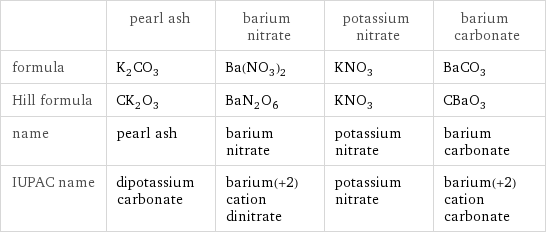
| pearl ash | barium nitrate | potassium nitrate | barium carbonate formula | K_2CO_3 | Ba(NO_3)_2 | KNO_3 | BaCO_3 Hill formula | CK_2O_3 | BaN_2O_6 | KNO_3 | CBaO_3 name | pearl ash | barium nitrate | potassium nitrate | barium carbonate IUPAC name | dipotassium carbonate | barium(+2) cation dinitrate | potassium nitrate | barium(+2) cation carbonate
Substance properties
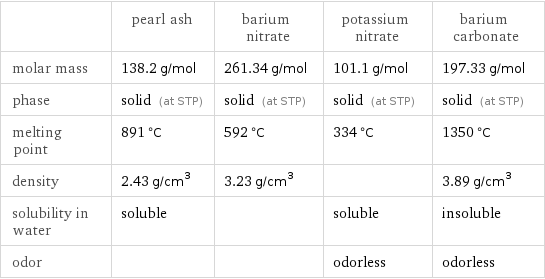
| pearl ash | barium nitrate | potassium nitrate | barium carbonate molar mass | 138.2 g/mol | 261.34 g/mol | 101.1 g/mol | 197.33 g/mol phase | solid (at STP) | solid (at STP) | solid (at STP) | solid (at STP) melting point | 891 °C | 592 °C | 334 °C | 1350 °C density | 2.43 g/cm^3 | 3.23 g/cm^3 | | 3.89 g/cm^3 solubility in water | soluble | | soluble | insoluble odor | | | odorless | odorless
Units
